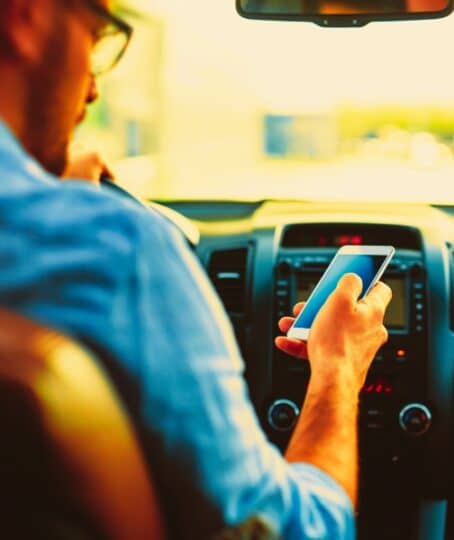
What to Do If You’re Injured in a Car Accident While Working in Illinois Work-related car accidents are common. Between...


Distracted driving includes any activity that takes the attention of a driver away from the primary driving task at hand. There are many ways besides texting that one can be distracted while driving. Research has shown that close to three-quarters of drivers partake in some form of distracted driving. Any form of distracted driving endangers the safety of drivers, passengers, and bystanders.

There are three types of distractions: visual, manual, and cognitive distractions.
Visual distractions include any activities that take the eyes of drivers off the road. One is visually distracted when grabbing something from his or her bag, watching a video, sending a quick text response, or reading a message on his or her cell phone. Looking in the mirror to check one’s appearance and looking at maps, GPS, billboards, or other signs on the side of the road also result in visually distracted driving.
Manual distractions require a driver to take one or both hands off the steering wheel. Picking up a cup of coffee or cell phone to call or text, adjusting the radio, wearing clothes, shaving, applying makeup, and combing hair require drivers to take at least one hand off the wheel.
Cognitive distracted driving happens when a driver is not focused on driving. The distractions take the driver’s mind off the road or what is happening around him or her. Cognitive distractions include disciplining or caring for children, focusing on a conversation with a passenger or a phone conversation, and concentrating on a stressful situation unrelated to driving.
Under Illinois law, drivers are not allowed to use handheld electronic communication devices while driving. Many drivers, however, continue to use their smartphones to send texts, check mail, and make calls while driving. By mid-March, Illinois State Police had already issued more than 800 citations for distracted driving.
The use of cell phones is especially dangerous because it poses a trifecta of challenges: visual, cognitive, and manual distraction. Reading and sending texts is the most alarming driving distraction. If a person is driving at 55 mph and he or she glances away from the road for just five seconds to read or send a text, it is comparable to driving the vehicle a full football field’s length with his or her eyes closed.
According to the NHTSA (National Highway Traffic Safety Administration), about half of all drivers eat or drink while driving. Drivers who eat or drink are likely to glance away from the road and take their hands off the steering wheel. Other activities that commonly cause distracted driving include talking to other passengers, adjusting the car radio, using the navigation system, interacting with children in the backseat, and personal grooming.
Distracted driving behavior puts distracted drivers and everybody around them at risk. One study found texting while driving can slow a driver's reactions by 35%. Other possible consequences of distracted driving include; not maintaining the proper lane position, lower situational awareness, inability to recognize traffic signs/signals, and failure to execute emergency driving maneuvers.
The risk of an accident increases when drivers divert their attention away from the task of driving for over two seconds at a time. The NHTSA reported that 3,142 people were killed and approximately 424,000 people injured in crashes connected to distracted driving in 2019.
Distracted drivers face stiff penalties in Illinois. Additionally, victims of accidents in which distracted driving was a factor could be entitled to compensation for their losses. They often work with lawyers for car accidents to recover compensation for past and future medical treatments, emotional trauma, lost wages, and pain and suffering.
Drivers can avoid distracted driving accidents by following a few safety tips. One should put his or her phone away when getting behind the wheel. It is advisable to put it in a place that will not be easily reachable while driving. Using a phone in hands-free mode also takes a driver’s attention off driving.
If a driver has to text, check emails, or make a call, he or she should pull over to a safe place to perform the activities. Pulling over is also an excellent idea when one has to care for a child in the backseat. Before getting on the road, a person should give himself or herself enough time to complete tasks like:
Drivers should also pull over to eat or drink, rather than consuming food or beverages on the go.
You will also be interested in:

What to Do If You’re Injured in a Car Accident While Working in Illinois Work-related car accidents are common. Between...

Why Pedestrian Accidents in Parking Lots Surge During Summer in Illinois As temperatures rise, more individuals tend to engage in...

Drowsy drivers are a serious and often overlooked danger on Illinois roads. Each year, fatigued drivers contribute to thousands of...